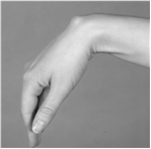Common sites of ganglions
- Wrist: dorsal
- Wrist: volar radial
- Flexor tendon sheath (at base of volar (palmar) finger, midline)
- Distal interphalangeal joint (DIPJ) ganglion, commonly called a mucous cyst
- Proximal interphalangeal joint (PIPJ) ganglion
Wrist ganglions
Wrist ganglions are subcutaneous lumps that appear at the level of the wrist, classically in two specific locations – either on the dorsal aspect of the wrist or the radial side of the volar aspect. They classically affect young people. They can be hard or soft; they might become harder or more visible with wrist movements. They typically fluctuate in size over time and can be multiloculated. Volar/radial ganglions may feel pulsatile due to transmitted pulsations from the radial artery.



Ganglions are harmless, rarely cause a problem, and we rarely operate on them. They often resolve spontaneously over months or years. They are rarely seen in older people. Surgery is not first line treatment for wrist ganglions, as risks of surgery often outweigh the benefits.
Ganglion aspiration under local anaesthetic has a high rate of recurrence (50 – 80%). However it can be helpful to confirm the diagnosis, where this is in question. The GP can aspirate the ganglion with a large (white) needle if happy to do so under local anaesthesia. The aspiration of jelly fluid (looks like Royal Jelly) confirms the diagnosis and the patient can be reassured.
Flexor Sheath ganglions
Flexor tendon sheath ganglions occur at base of the finger on the volar (palmar) aspect most commonly in midline. The patient often describes a pea-sized lump felt under the skin. They occur at the level of the proximal finger crease or over the A1 pulley. They commonly affect young adults and can occur in children. They can cause discomfort. Further, the patient may complain of the lump being prominent and uncomfortable on gripping objects. They may burst or disappear spontaneously.
Flexor sheath ganglions do not move consensually with the flexor tendons if the digit is actively flexed. If the lump moves with the flexor tendon / movement of the finger, it is attached to the finger tendons. Further if the lump results in locking of the finger, then this should be treated as trigger finger, for more details see TriggerFinger.aspx.
Mucous cysts
Further information on mucous cysts can be found on the MucousCyst.aspx page.
Who to refer:
- Diagnostic difficulties
- Atypical hard lumps displaying a progressive growth pattern only
- Pain unresponsive to primary care treatment
- Please make clear reason for referral on SCI-GW
Who not to refer:
- Straightforward wrist ganglion diagnosis without functional problems
- Patients referred to the Hand Service with a simple wrist ganglion will be sent an information sheet and a letter. The letter gives them to option to opt-in to secondary care treatment if they feel it is needed having read the information. The letter includes a telephone number for them to call the department for a clinic appointment date.
- Patients with wrist lumps of uncertain aetiology should be referred to the hand service, where they will be triaged.
- Patients with flexor sheath ganglions which fail to settle with primary care measures can be referred.
How to refer:
- SCI-GW: St John’s Hospital >> Plastic Surgery – Hands Service >> LI Hand Clinic
Wrist Ganglions
- For a diagnosis of wrist ganglion, reassure the patient and give them the information leaflet under the ‘Patient Information’ tab. PIL BSSH GANGLIONS Aug18
- Advise the patient to try pain relief and to modify activities causing discomfort.
- The GP can advise the occasional use of a wrist splint.
- The GP can attempt aspiration under local anaesthesia, as they feel is appropriate.
Flexor Sheath Ganglions
- Advise the patient to modify activities causing discomfort.
- Advise the patient to try pain relief
- For a diagnosis of flexor sheath ganglion, reassure the patient and give them the information leaflet under the ‘Patient Information’ tab.PIL BSSH GANGLIONS Aug18
- The GP can attempt aspiration under local anaesthesia, as they feel is appropriate, as flexor sheath ganglia can be burst with local anaesthetic infiltration at clinic.













